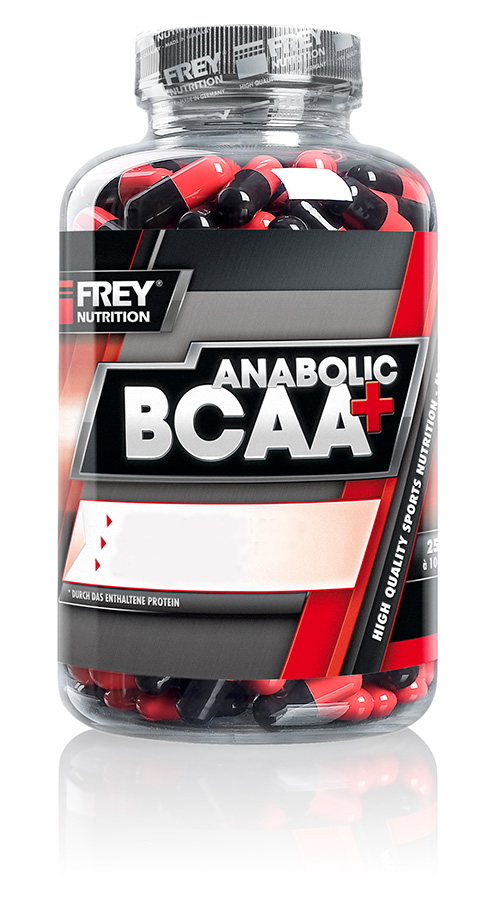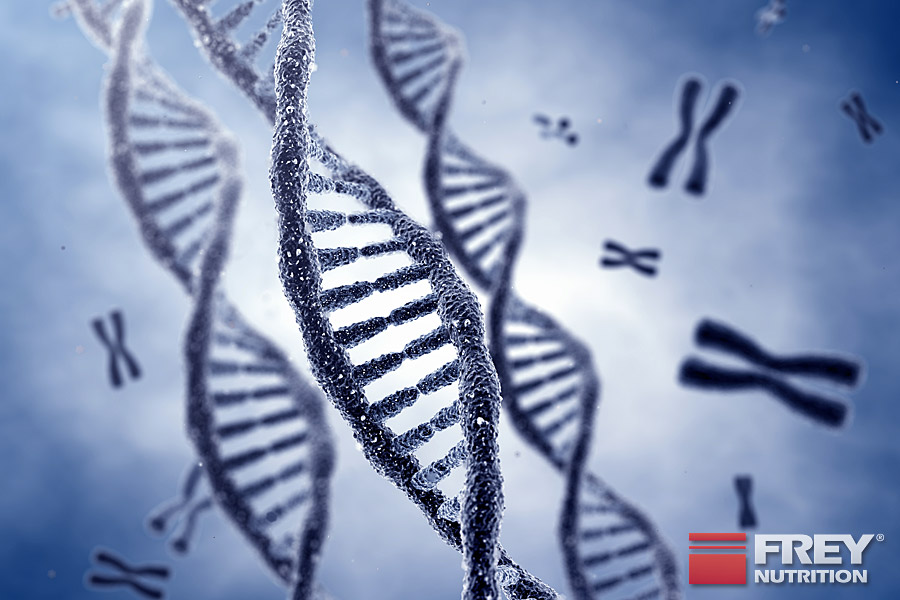WHAT ARE AMINO ACIDS AND WHAT ARE THEY GOOD FOR?
In total there are 20 AMINO ACIDS that are important for the human body. The body needs amino acids to build its own proteins.
This includes all body cells, enzymes, hormones, hemoglobin, antibodies and other substances that the body produces itself. Amino acids are the individual building blocks of proteins and are vital for every human being. Proteins contribute to the building and maintenance of muscle mass. We consume proteins through our daily diet, which the digestive system breaks down into individual amino acids.
Since the body AMINO ACIDS no longer has to be broken down, amino acids are considered to be "pre-digested" protein. Eight amino acids are essential for humans, i.e. they must be supplied with daily food: L-isoleucine, L-leucine, L-lysine, L-methionine, L-phenylalanine, L-threonine, L-tryptophan and L-valine. Especially during increased physical exertion, such as through strength training or increased sporting activities, our organism needs more amino acids to meet the increased demand. Often the daily diet is not sufficient to optimally cover the increased consumption. In such cases, amino acid preparations are useful. Complex amino acid products such as AMINO TABS are well suited for the general basic supply of amino acids, as they contain all 20 amino acids in a ratio that is optimal for the body and thus make an effective contribution to covering additional requirements.
Special amino acid preparations in the form of BCAAs such as: ANABOLIC BCAA + are particularly suitable for taking before and after training in order to stimulate anabolic (= muscle-building) metabolic processes through the protein they contain and to avoid catabolic (= muscle-degrading) processes.
"NORMAL FOOD SHOULD ALWAYS BE THE BASIS. AMINO ACID PREPARATIONS ARE ONLY USEFUL AND EFFECTIVE WHEN THE INCREASED NEEDS CANNOT BE ADEQUATELY COVERED." (QUOTE: A. FREY)
DISTRIBUTION OF AMINO ACIDS
NON-ESSENTIAL AMINO ACIDS:
- L-Alanine
- L-aspartic acid
- L-glutamine/-acid
- L-Glycine
- L-Proline
- L-Serine
SEMI-ESSENTIAL AMINO ACIDS:
- L-Arginine
- L-Cysteine
- L-Histidine
- L-Tyrosine
ESSENTIAL AMINO ACIDS:
- L-Isoleucine (BCAA)
- L-Leucine (BCAA)
- L-Lysine
- L-Methionine
- L-Phenylalanine
- L-tryptophan
- L-Threonine
- L-Valine (BCAA)
Non-essential amino acids are amino acids that do not necessarily have to be ingested with food, as they can be synthesized by the body itself. They are important for performance and muscle building, but are not vital for the organism. Semi-essential amino acids must only be taken with food in certain situations of increased need, for example during growth or in the event of serious injuries. Essential amino acids are vital amino acids that the organism cannot produce itself and therefore must be ingested with food.
AMINO ACIDS IN THE RIGHT AMOUNT AT THE RIGHT TIME
Amino acid preparations are available in liquid, powder, tablet and capsule form. They are also offered in peptide form and in free form, which ensures first-class quality with increased absorption capacity. Apart from the biological value of the raw material used, the absorption rate of amino acid preparations is one of the decisive criteria in comparison to proteins.
The body must first break down proteins enzymatically in the stomach. They then pass through the intestinal walls into the bloodstream using specific transport molecules. Amino acids, especially oligopeptides made up of up to three amino acids, no longer need to be broken down and can therefore be added to the amino acid pool more quickly. This advantage is particularly important when amino acids are taken at times of increased need, which requires rapid coverage.
AMINO ACIDS ARE SUPERIOR TO PROTEINS IN THEIR RAPID ABSORPTION AND ABSORPTION RATE.
Consequently, targeted amino acid supplements before and after training are extremely effective, as the amino acid molecules no longer need to be broken down and are therefore immediately available to the muscle cells. While proteins must first be broken down through digestion in order to develop their positive properties, this is no longer necessary with amino acids because they are already in a hydrolyzed form.
The need for protein and amino acids is particularly high after training, which makes the intake of amino acids sensible. The different forms of administration differ in their absorption speed.
Liquid preparations, those in capsule and powder form are absorbed much faster than amino acids in tablets, which is why the former are particularly suitable in the morning on an empty stomach, before and after training.
Tablets sometimes require several hours for their active ingredients to enter the bloodstream. They are therefore particularly suitable for amino acid supply overnight and for a constant amino acid supply during diet phases, especially in the form of BCAAAS in tablet form. Tablets are digested slowly and released with a delay, which promotes a longer supply of amino acids.
However, amino acids are not suitable as the sole source of protein, as the body metabolizes them far too quickly and it is therefore difficult to achieve a consistent level of amino acids. For this purpose, protein powder should be used as a basic protein source. These are usually pre-split (concentrates, isolates and hydrolysates) and can therefore be used more quickly than dietary proteins, but they supply the body for far longer than is the case with amino acids.
NATURAL SOURCES OF AMINO ACIDS
Amino acids can be found in both animal and plant foods. Meat, fish, eggs, milk, dairy products, soybeans and legumes are particularly rich in protein.
Amino acids of animal origin are better utilized by the body than those of plant origin, as the former have a similar structure to that of humans. Plant proteins also have cell walls that hinder the digestion of proteins and their amino acids.
THE BENEFITS OF AMINO ACIDS FOR ATHLETES
During performance-oriented training, protein turnover is increased and often leads to a negative nitrogen balance, i.e. muscle proteins are used to generate energy. Proteins and their amino acids can prevent this process by providing the vital nitrogen molecules that are essential for building body proteins. Amino acids are involved in protein metabolism and nitrogen balance, and some of them even participate in energy metabolism under certain physiological circumstances (e.g. during dieting phases or during long endurance exercises).
The metabolism of proteins and amino acids is all the more effective if an adequate supply of essential vitamins such as vitamin B1, B2, B6, folic acid, biotin and niacin is ensured at the same time, especially since these
- for protein and amino acid synthesis
- on glucose and energy metabolism
- to regulate hormone activity
- for heart, nerve and muscle function
- to form red blood cells and
- to maintain the function of the immune system
can contribute.
If the daily diet does not provide enough dietary proteins with essential amino acids and/or there is an increase in requirements due to increased physical strain, pure amino acid preparations can compensate for this by helping to stabilize the nitrogen and protein balance.
Since almost all cells are made up of proteins, these not only play a significant role for the athlete and his muscles, but are also important for healthy and strong hair, healthy fingernails and healthy and firm skin.
It is precisely for this reason that it is important to ensure a sufficient and appropriate supply of vital proteins and amino acids, especially in order to prevent deficiencies in good time and thus promote the maintenance of cell health.
VITAMINS OF THE B-COMPLEX CONTRIBUTE TO PROTEIN UTILISATION THROUGH THEIR METABOLISM INVOLVEMENT.
INCREASED NEEDS AMONG ATHLETES
Since athletes have a higher protein requirement, they also need to provide their bodies with more products containing amino acids. Protein sources include meat, eggs and dairy products. However, these foods are usually very high in fat, so that in addition to the desired protein, a significant amount of fat is also consumed.
By using special nutritional supplements, the body can be supplied with high-quality proteins and important amino acids, but completely fat-free, which means that a low-fat diet can be maintained. This allows athletes to optimally cover their additional needs and provide their bodies with sufficient nutrients without having to worry about consuming saturated fats, which are often found in meat.
For optimal protein utilization, vitamins of the B-COMPLEX cannot be missing, especially since they are involved in the normal synthesis and metabolism of proteins, steroids, vitamin D and numerous messenger substances.
BCAAS | ESSENTIAL AND USEFUL
BCAAAS consist of the three essential amino acids L-leucine, L-isoleucine and L-valine. The supply of essential amino acids is vital for the body because it cannot produce them itself.
Therefore, they must be consumed with food. Athletes like to use BCAA in both strength and endurance sports to maintain the natural balance in energy and protein metabolism.
THE OPTIMAL TIMES TO TAKE BCAAs ARE BEFORE AND AFTER TRAINING.
The body needs them to re-synthesize the amino acids glutamine and alanine that are used up during high levels of exertion, e.g. during training, and thus ensure that the muscles are adequately supplied with BCAAs. BCAAs are needed to build almost all proteins. Approximately 35% of muscles consist of BCAAs. They also play a key role in the transport of nitrogen and energy between the muscles and the liver. They can be reversibly converted into the corresponding keto acids (deamination/amination).
BCAA amino acids are an ideal supplement to conventional amino acid products and are regularly used by many athletes from numerous sports. On training days, the ideal times to take them are before and after training. On non-training days, they should be taken throughout the day with meals. On training days, BCAAs are always preferred in capsule and powder form due to their rapid absorption, but on non-training days, BCAA tablets are more popular for slow absorption.
ATHLETES HAVE AN INCREASED NEED FOR BCAAS
BCAAs normalize the tryptophan concentration in the brain and thus the serotonin concentration, which can lead to less fatigue. BCAAs are found in almost all proteins. Particularly high amounts are found in whey protein (20 - 25 g/100 g), casein (17 - 22 g/100 g), whole egg (17 - 20 g/100 g) and soy (15 - 19 g/100 g).
BCAAs should always be taken in the optimal ratio (leucine: isoleucine: valine = 2:1:1) to each other, otherwise a deficiency can occur. BCAAs are relatively insoluble in water and therefore limit the solubility of many amino acid mixtures.
Overdose symptoms with BCAAs are not known at doses of up to 50 g/day. If there is an excess of BCAAs, they are converted into glucose or glycogen.
When taken before training, BCAAs can also be used to generate energy. Since our body first uses free BCAAs from the blood plasma, a regular supply of BCAAs is particularly important.
THE CORRECT TIME TO TAKE BCAAs
To make the most of the effect of BCAAs, they should be taken with water around 30 minutes before training. At this point, BCAAs in powder or capsule form make the most sense, as this is the fastest way for muscle cells to absorb them. 1 g of BCAAs should be taken for every 10 kg of body weight. For an athlete weighing 80 kg, this corresponds to 8 g = 8 capsules.
BCAAs in powder form should not be mixed with water due to their poor water solubility, but should be taken directly with a glass of water.
DURING DIET PHASES, BCAA TABLETS ARE IDEAL FOR A SLOW AND CONSTANT SUPPLY!
Immediately after training, intake with protein like TRIPLE WHEY and quickly available carbohydrates as maltodextrin DE 12 such as MALTO 95 makes sense. BCAAs are therefore taken by well-informed athletes together with PWN. After training, the same dosage applies as before.
During diets, BCAAs are suitable for effectively covering the increased BCAA requirements of the muscles. A balanced intake throughout the day is the most sensible option when dieting, as the BCAAs are then evenly available to the muscles. In this case, the intake of BCAAs in tablet form is recommended, as they are available in the BCAA TABS Since the branched-chain amino acids are absorbed slowly and constantly and are available to the muscle cells over a longer period of time, they can optimally develop their positive properties.
GLUTAMINE | ONE OF THE MOST IMPORTANT AMINO ACIDS
L-GLUTAMINE is referred to as a "conditionally essential" amino acid. It is the most common amino acid in skeletal muscles. Over 60% of all free amino acids consist of glutamine. Glutamine can be converted into glutamic acid in the body and vice versa. The body can form glutamine from glutamic acid by absorbing ammonia. Glutamine is found in almost all proteins. Particularly large amounts of glutamine are found in: casein (24%), whey protein (7%), corn and soy protein (6%).
Deficiency symptoms include a weakened immune status and delayed wound healing. Depending on the training phase and intensity, athletes have a greatly increased need for glutamine. Glutamine is a fundamental component of proteins, which help prevent fatigue and the consequences of overtraining and thus contribute to muscle maintenance (= anti-catabolic effect).
Depending on the intensity of the physical exertion, athletes use between 5 and 20 g of glutamine per intake. For the proper absorption of glutamine, a sufficient supply of vitamin B6 is required. The optimal time to take it is directly after training, a phase of increased nutrient requirements of the body and the trained muscles. A PWN (= post-workout nutrition, the first meal after training) with MALTO 95 combined with TRIPLE WHEY and glutamine has proven to be successful and is used by numerous performance-oriented athletes, primarily to cover the increased nutrient requirements effectively and quickly. During the diet phase, smaller doses spread over the day make sense to counteract any glutamine deficiency and ensure an adequate supply of this important amino acid.
GLUTAMINE AND ENERGY
Glutamine is the main fuel for rapidly dividing cells such as intestinal cells. Glutamine taken orally is already absorbed in the intestinal tract, which is why larger amounts of conventional glutamine are required to achieve an increased glutamine concentration in the muscle. Glutamine di- and tripeptides, which are found in GLUTAMINE X4 These are also better absorbed by the body than conventional glutamine and reduce the likelihood of unwanted conversion into ammonia. Glutamine can be converted into glucose in the kidneys without affecting glucagon and insulin levels. It can therefore also contribute to energy production, which can avoid fat storage caused by insulin. Studies on mice show that glutamine can counteract dietary fat storage and thus help regulate body weight. Further studies are needed to prove the extent to which these study results can be transferred to humans.
Glutamine also serves as fuel for the cells of the immune system, so an effect on the immune system cannot be ruled out. Here, too, further scientific studies are needed to uncover all the benefits of glutamine.
GLUTAMINE AND PROTEIN SYNTHESIS
Since glutamine is involved in the transport of nitrogen in addition to protein, it can support protein synthesis. According to scientific studies, glutamine promotes the absorption of other amino acids.
During intensive muscle training, the loss of glutamine can increase to up to 40 g. Since this is more than the body can synthesize itself, it is advisable to take glutamine after exercise to compensate for the loss and provide the muscle cells with sufficient glutamine.
























